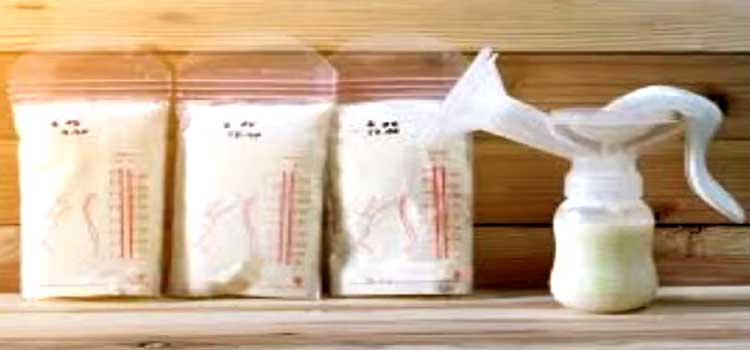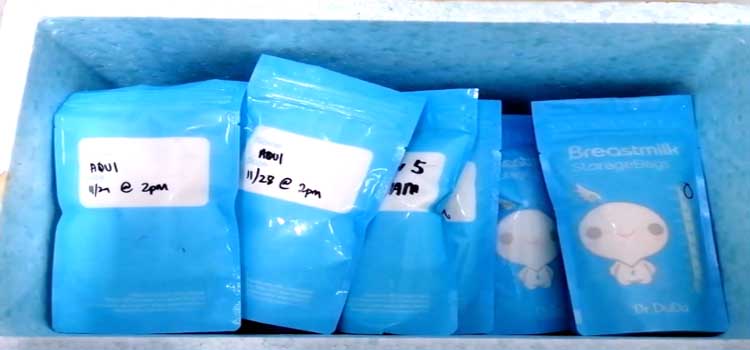As an Amazon Associate I earn from qualifying purchases.
Are you a breastfeeding parent planning a day out with your child? Knowing how to pack breast milk for a day out is essential for maintaining its quality and avoiding spoilage while you’re on the go. Many parents prioritize providing their kids with nutritious breast milk when away from home. However, managing breast milk storage and transportation requires considerable preparation and attention.
In this in-depth guide, we’ll walk you through the entire process of pack breast milk for a day out. We’ll review every important detail to ensure you can easily manage your nursing journey while on the go, from choosing the right storage containers to keeping the ideal temperature while travelling.

Selecting the Right Storage Containers
Making the right storage container choice is essential when preparing breast milk for a day out. The containers you use directly impact the safety and freshness of the breast milk being preserved for your baby’s ingestion.
Breast milk can be stored in various containers, including glass containers, BPA-free plastic bottles, and storage bags. Different types have different benefits, like portability, toughness, and simplicity of usage.
Several considerations should be made while choosing storage containers, including the container’s capacity, the material’s safety, and its compatibility with breast pumps for effective expressing and storing.
Preparing Breast Milk for Transportation

Breast milk preparation for transportation necessitates close attention to detail to preserve its quality and safety for your baby’s consumption. Breast milk containers must be properly labelled to guarantee precise tracking and organization.
To avoid wastage and to prioritize using older milk first, clearly mark each container with the expression date. In addition, if the milk is kept in a storage area with other children’s supplies, such as a daycare centre, mention your baby’s name.
To maintain the freshness of breast milk, handle and store it according to specified instructions before leaving the house. Use sterilized, clean containers and thoroughly wash your hands when expressing milk.
To avoid contamination, refrigerate the expressed breast milk in airtight containers made specifically for storing breast milk. To avoid leaks during transit, make sure the containers are tightly packed.
Keeping everything hygienic and tidy at all times is crucial. Breast pumps, storage containers for breast milk, and other equipment used in milk expression should be cleaned and sanitized regularly. To reduce the chance of contamination, avoid contacting the inside of bottle rims or lids.
Your baby will get safe and nourishing milk while you’re on the go if you prepare your breast milk pack according to these guidelines.
Maintaining Optimal Temperature During Travel
Breast milk must be transported at the ideal temperature to retain its nutritional value and purity. Variations in temperature have the potential to damage milk’s quality, causing it to deteriorate and lose vital nutrients.
Therefore, even while you’re not at home, it’s critical to give temperature regulation first priority to guarantee that your baby gets nutritious and safe milk.
Using practical methods for keeping breast milk cool when travelling is essential to achieving this. One such tactic is using insulated cooler bags or packs made especially for preserving breast milk. Because of their thermal insulation, these bags can keep a steady low temperature even in various weather situations.
You may establish a dependable cold storage environment in these insulated bags and guarantee that the milk stays chilly during your travels by packing your breast milk containers with ice packs or frozen gel packs.
Moreover, minimizing heat transmission and maximizing cooling effectiveness are achieved by firmly packing your breast milk containers inside the insulated bag. By forming a barrier against outside heat, this design helps protect the milk from temperature changes.
You may safely maintain the ideal temperature of breast milk while traveling by using these techniques and purchasing high-quality insulated cooler bags or packs. This will ensure that your baby gets safe and nourishing milk wherever your adventures take you.
Packing Breast Milk Accessories
When packing breast milk for a day out, it’s important to consider the accessories that will help guarantee the milk stays fresh and safe for your infant to consume. Two of the most important things to consider are cooler bags and ice packs.
These things are essential for keeping the breast milk at the ideal temperature, particularly if you’re going to be gone from home for a long time. At the same time, cooler bags offer insulation to avoid temperature variations, and ice packs help keep the milk cold.
In addition to ice packs and cooler bags, organizing breast milk storage in your diaper bag or backpack is essential for maintaining ease and accessibility on your trip. Consider utilizing specialized compartments or pouches in your suitcase to keep breast milk containers apart from other goods.
This helps avoid accidental spills or leaks while making it easy to feed your baby. Using transparent or labelled storage pouches might help you stay organized and track your breast milk supplies.
You can efficiently manage breast milk storage while on the go and make sure your baby gets safe and nutritional milk wherever your adventures take you by including these necessary equipment and organizing techniques into your packing routine.
Handling Breast Milk During the Outing
When handling breast milk on outings, it’s important to pay close attention to its safety and freshness so your infant can eat it. The following are some rules to abide by:
Recommendations for Giving Your Infant Breast Milk While Traveling:
- Ensure you always have sanitary feeding supplies, like nipples and bottles.
- Before handling breast milk or the feeding gear, thoroughly wash your hands.
- Use a bottle warmer or submerge the container in warm water to reheat the breast milk. Microwaving breast milk can destroy nutrients and cause hot spots, so avoid doing so.
- Reduce distractions by feeding your infant in a calm, cozy setting.
Proper Storage of Partially Used Breast Milk Containers:
If your baby doesn’t finish a feeding, put the partially used breast milk container in a sanitized, airtight storage bag or container right away. To guarantee proper rotation and use, label the container with the feeding date and time.
Managing Unexpected Situations (e.g., Delays, Emergencies)
- In case of unforeseen delays, always keep an extra supply of clean water, feeding equipment, and breast milk on hand.
- If you think there might be a delay in keeping the breast milk at the proper temperature, carry extra ice packs or frozen gel packs.
- In an emergency, prioritize your baby’s feeding requirements and choose a secure area to feed them.
Following these tips and being ready for anything will help you confidently manage breast milk when out and about, giving your infant access to nutritious and safe milk wherever you go.
Returning Home and Properly Storing Unused Breast Milk
Returning home from an outing with unused breast milk requires proper handling and storage to maintain its quality and safety for future use. Here are the steps to follow:
Steps to Follow Upon Returning Home from the Outing:
- Hand wash your hands with soap and water before handling the breast milk. Place any leftover breast milk from the insulated cooler bag or pack it in the refrigerator as soon as possible.
- Before storing the breast milk containers, check them for leaks or signs of damage.
Best Practices for Storing Unused Breast Milk:
- Keep unused breast milk in clean, BPA-free containers developed exclusively for breast milk storage.
- To ensure correct rotation and use, mark each container with the expression date and time.
- Place the breast milk containers on the refrigerator’s coldest shelf, such as the rear or bottom, to keep the breast milk containers at a consistent temperature.
Safety Considerations for Storing and Reusing Breast Milk:
- To maintain refrigerated breast milk’s freshness and nutritional value, use it within four to five days.
- If you don’t plan to utilize the breast milk right away, you could freeze it.
- Thaw frozen breast milk overnight in the fridge or submerge the container in warm water before reheating it. Breast milk should not be microwaved since this can damage nutrients and produce hot spots.
- To stop bacteria from growing, throw away unused or leftover breast milk that has been kept at room temperature for longer than two hours.
You can safely store and repurpose leftover breast milk according to these guidelines and take safety precautions so your baby will always have access to wholesome and safe milk for feeding.
Conclusion
It doesn’t have to be difficult to pack breast milk for a day trip. Breastfeeding mothers can enjoy outings with confidence, knowing that their baby’s nutritional needs are being met, if they prepare carefully and pay close attention to detail.
No matter where your travels take you, you can make sure that your breast milk is safe and fresh for your baby to consume by according to these rules and recommendations on How To Pack Breast Milk For A Day Out .
FAQs
Keep breast milk chilled using insulated cooler packs or bags. Store breast milk in BPA-free bags or containers. Place ice or gel packs in the insulated cooler bag to keep contents cold all day.
Before leaving the house, move breast milk from the refrigerator into insulated cooler bags or packs to store it for trips. Tightly pack the containers within the cooler bag to optimize chilling effectiveness and preserve the freshness of the milk.
Carrying a bottle of breast milk with you everywhere requires planning ahead. Use a clean, sterile bottle when feeding your child while out of the house. To avoid spills, leave space at the top of the bottle when adding the appropriate amount of breast milk. To keep the bottle sanitary while in transit, tightly close the cap and nipple with a clean hand.
Use enough insulation in your insulated cooler bags or packs to keep breast milk cold when travelling. Fill the cooler bag with more ice or frozen gel packs to keep the interior cold. Reduce how often you open the cooler bag to stop heat from getting inside and affecting the breast milk’s temperature.
Amazon and the Amazon logo are trademarks of Amazon.com, Inc, or its affiliates.
Leave a Reply